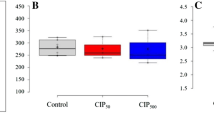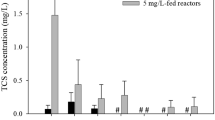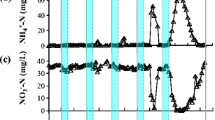Abstract
Examining the relationship between biodiversity and functional stability (resistance and resilience) of activated sludge bacterial communities following disturbance is an important first step towards developing strategies for the design of robust biological wastewater treatment systems. This study investigates the relationship between functional resistance and biodiversity of dominant bacterial taxa by subjecting activated sludge samples, with different levels of biodiversity, to toxic shock loading with cupric sulfate (Cu[II]), 3,5-dichlorophenol (3,5-DCP), or 4-nitrophenol (4-NP). Respirometric batch experiments were performed to determine the functional resistance of activated sludge bacterial community to the three toxicants. Functional resistance was estimated as the 30 min IC50 or the concentration of toxicant that results in a 50% reduction in oxygen utilization rate compared to a referential state represented by a control receiving no toxicant. Biodiversity of dominant bacterial taxa was assessed using polymerase chain reaction-terminal restriction fragment length polymorphism (PCR-T-RFLP) targeting the 16S ribosomal RNA (16S rRNA) gene. Statistical analysis of 30 min IC50 values and PCR-T-RFLP data showed a significant positive correlation (P < 0.05) between functional resistance and microbial diversity for each of the three toxicants tested. To our knowledge, this is the first study showing a positive correlation between biodiversity of dominant bacterial taxa in activated sludge and functional resistance. In this system, activated sludge bacterial communities with higher biodiversity are functionally more resistant to disturbance caused by toxic shock loading.



Similar content being viewed by others

References
Briones AM, Daugherty BJ, Angenent LT, Rausch K, Tumbleson M, Raskin L (2007) Microbial diversity and dynamics in multi- and single-compartment anaerobic bioreactors processing sulfate-rich waste streams. Environ Microbiol 9:93–106
Burmølle M, Web JS, Rao D, Hansen LH, Sørensen SJ, Kjelleberg S (2006) Enhanced biofilm formation and increased resistance to antimicrobial agents and bacterial invasion are caused by synergistic interactions in multispecies biofilms. Appl Environ Microbiol 72:3916–3923
Cook KL, Garland JL, Layton AC, Dionisi HM, Levine LH, Sayler GS (2006) Effect of microbial species richness on community stability and community function in a model plant-based wastewater processing system. Microb Ecol 52:725–737
Crosby LD, Criddle CS (2003) Understanding bias in microbial community analysis techniques due to rrn operon copy number heterogeneity. Biotechniques 34:790–799
Curtis TP, Head IM, Graham DW (2003) Theoretical ecology for engineering biology. Environ Sci Technol 64A–70A
Curtis TP, Sloan WT (2004) Prokaryotic diversity and its limits: microbial community structure in nature and implications for microbial ecology. Curr Opin Microbiol 7:221–226
Daims H, Purkhold U, Bjerrum L, Arnold E, Wilderer PA, Wagner M (2001) Nitrification in sequencing biofilm batch reactors: lessons from molecular approaches. Water Sci Technol 43:9–18
Dalzell DJB, Alte S, Aspichueta E, de la Sota A, Etxebarria J, Gutierrez M, Hoffmann CC, Sales D, Obst U, Christofi N (2002) A comparison of five rapid direct toxicity assessment methods to determine toxicity of pollutants to activated sludge. Chemosphere 47:535–545
Dunbar J, Ticknor LO, Kuske CR (2000) Assessment of microbial diversity in four southwestern United States soils by 16S rRNA gene terminal restriction fragment analysis. Appl Environ Microbiol 66:2943–2950
Dunbar J, Ticknor LO, Kuske CR (2001) Phylogenetic specificity and reproducibility and new method for analysis of terminal restriction fragment profiles of 16S rRNA genes from bacterial communities. Appl Environ Microbiol 67:190–197
Eichner CA, Erb RW, Timmis KN, Wagner-Dobler I (1999) Thermal gradient gel electrophoresis analysis of bioprotection from pollutant shocks in the activated sludge microbial community. Appl Environ Microbiol 65:102–109
Fernandez AS, Hashsham SA, Dollhope SL, Raskin L, Glagoleva O, Dazzo FB, Hickey RF, Criddle GS, Tiedje JM (2000) Flexible community structure correlates with stable community function in methanogenic bioreactor communities perturbed by glucose. Appl Environ Microbiol 66:4058–4067
Forney LJ, Zhou X, Brown CJ (2004) Molecular microbial ecology: land of the one-eyed king. Curr Opin Microbiol 7:210–220
Gentile M, Yan T, Tiquia SM, Fields MW, Nyman J, Zhou J, Criddle CS (2006) Stability in a denitrifying fluidized bed reactor. Microb Ecol 52:311–321
Girvan MS, Campbell CD, Killham K, Prosser JI, Glover LA (2005) Bacterial diversity promotes community stability and functional resilience after perturbation. Environ Microbiol 7:301–313
Grady CPL, Daigger GT, Lim HC (eds) (1999) Biological Wastewater Treatment, 2nd edn. Marcel Dekker, New York
Grady CPL, Smets BF, Barbeau DS (1996) Variability in kinetic parameter estimates: a review of possible causes and a proposed terminology. Water Res 30:742–748
Graham DW, Smith VH (2004) Designed ecosystem services: application of ecological principles in wastewater treatment engineering. Front Ecol Environ 2:199–206
Griffiths BS, Kuan HL, Ritz K, Glover LA, McCaig AE, Fenwick C (2004) The relationship between microbial community structure and functional stability, tested experimentally in an upland pasture soil. Microb Ecol 47:104–113
Griffiths BS, Ritz K, Bardgett RD, Cook R, Christensen S, Ekelund F, Sorensen SJ, Baath E, Bloem J, de Ruiter PC, Dolfing J, Nicolardot B (2000) Ecosystem response of pasture soil communities to fumigation-induced microbial diversity reductions: an examination of the biodiversity-ecosystem function relationship. Oikos 90:279–294
Gutierrez M, Etxebarria J, de las Fuentes L (2002) Evaluation of wastewater toxicity: comparative study between Microtox and activated sludge oxygen uptake inhibition. Water Res 36:919–924
Hashsham SA, Fernandez AS, Dollhope SL, Dazzo FB, Hickey RF, Tiedje JM, Criddle GS (2000) Parallel processing of substrate correlates with greater functional stability in mathanogenic bioreactor communities perturbed by glucose. Appl Environ Microbiol 66:4050–4057
Hughes JB, Hellmann JJ, Ricketts TH, Bohannan BJM (2001) Counting the uncountable: statistical approaches to estimating microbial diversity. Appl Environ Microbiol 67:4399–4406
Juretschko S, Timmermann G, Schmid M, Scleifer KH, Pommerening-Roser A, Koops HP, Wagner M (1998) Combined molecular and conventional analyses of nitrifying bacterium diversity in activated sludge; Nitrosococcus mobilis and Nitrospira-like bacteria as dominant populations. Appl Environ Microbiol 64:3042–3051
Kitts CL (2001) Terminal restriction fragment patterns: a tool for comparing microbial communities and assessing community dynamics. Curr Issues Intest Microbiol 2:17–25
LaPara TM, Nakatsu CH, Pantea LM, Alleman JE (2002) Stability of the bacterial communities supported by a seven-stage biological process treating pharmaceutical wastewater as revealed by PCR-DGGE. Water Res 36:638–646
Liu WT, Marsh TL, Cheng H, Forney LJ (1997) Characterization of microbial diversity by determining terminal restriction fragment length polymorphisms of genes encoding 16S rRNA. Appl Environ Microbiol 63:4516–4522
Loreau M, Naeem S, Inchausti P, Bengtsson J, Grime JP, Hector A, Hooper DU, Huston MA, Raffaelli D, Schmid B, Tilman D, Wardle DA (2001) Ecology: biodiversity and ecosystem functioning: current knowledge and future challenges. Science 294:804–808
Love NG, Bott CB (2000) A review and needs survey of upset early warning devices. Water Environment Research Foundation; Report No. 99-WWF-2. Alexandria, VA.
Love NG, Bott CB (2002) Evaluating the role of microbial stress response mechanisms in causing biological treatment system upset. Water Sci Technol 46:11–18
Marquardt DW (1963) An algorithm for least squares estimation of parameters. J Soc Ind Appl Math 11:431–441
McCann KS (2000) The diversity–stability debate. Nature 405:228–233
McGrady-Steed J, Harris PM, Morin PJ (1997) Biodiversity regulates ecosystem predictability. Nature 390:162–165
Muyzer G, Smalla K (1998) Application of denaturing gradient gel electrophoresis (DGGE) and temperature gradient gel electrophoresis (TGGE) in microbial ecology. Antonie Leeuwenhoek 73:127–141
Osborn AM, Moore ERB, Timmis KN (2000) An evaluation of terminal-restriction fragment length polymorphism (T-RFLP) analysis for the study of microbial community structure and dynamics. Environ Microbiol 2:39–50
Oviedo MDC, Marquez DS, Alonso JMQ (2002) Toxic effects of metals on microbial activity in the activated sludge process. Chem Biochem Eng Q 16:139–144
Pedros-Alio C (2006) Marine microbial diversity: can it be determined? Trends Microbiol 14:257–263
Prosser JI, Bohannan BJM, Curtis TP, Ellis RJ, Firestone MK, Freckleton RP, Green JL, Green LE, Killham K, Lennon JL, Osborn MA, Solan M, van der Gast CJ, Young JP (2007) The role of ecological theory in microbial ecology. Nat Rev Microbiol 5:384–392
Ricco G, Tomei MC, Ramadori R, Laera G (2004) Toxicity assessment of common xenobiotic compounds on municipal activated sludge: comparison between respirometry and Microtox. Water Res 38:2103–2110
Rosello-Mora R, Amann R (2001) The species concept for prokaryotes. FEMS Microbiol Rev 25:39–67
Rowan AK, Snape JR, Fearnside D, Barer MR, Curtis TP, Head IM (2003) Composition and diversity of ammonia-oxidizing bacterial communities in wastewater treatment reactors of different design treating identical wastewater. FEMS Microbiol Ecol 43:195–206
Saikaly PE, Oerther DB (2004) Bacterial competition in activated sludge: theoretical analysis of varying solids retention times on diversity. Microb Ecol 48:274–284
Saikaly PE, Stroot PG, Oerther DB (2005) Assessing the impact of solids retention time on activated sludge bacterial diversity by 16S rRNA gene terminal restriction fragment length polymorphism. Appl Environ Microbiol 71:5814–5822
Schwartz MW, Brigham CA, Hoeksema JD, Lyons KG, Mills MH, van Mantgem PJ (2000) Linking biodiversity to ecosystem function: implications for conservation ecology. Oecologia 122:297–305
Shannon CE, Weaver W (1963) The mathematical theory of communication. University of Illinois Press, Urbana
Simpson EH (1949) Measurement of diversity. Nature 163:688
Sogin ML, Morrison HG, Huber JA, Welch DM, Huse SM, Neal PR, Arrieta JM, Herndl GJ (2006) Microbial diversity in the deep sea and the underexplored ‘rare biosphere’. Proc Natl Acad Sci 103:12115–12120
Solow AR (1993) A simple test for change in community structure. J Anim Ecol 62:191–193
Tilman D (1999) The ecological consequences of changes in biodiversity: a search for general principles. Ecology 80:1455–1474
Tilman D (2002) Biodiversity: population versus ecosystem stability. Ecology 77:350–363
Tilman D, Knops J, Wedin D, Reich P, Ritchie M, Siemann E (1997) The influence of functional diversity and composition on ecosystem processes. Science 277:1300–1302
von Canstein H, Kelly S, Li Y, Wagner-Dobler I (2002) Species diversity improves the efficiency of mercury-reducing biofilms under changing environmental conditions. Appl Environ Microbiol 68:2829–2837
von Wintzingerode F, Gobel UB, Stackebrandt E (1997) Determination of microbial diversity in environmental samples: pitfalls of PCR-based rRNA analysis. FEMS Microbiol Rev 21:213–229
Ward JH (1963) Hierarchical grouping to optimize an objective function. J Am Stat Assoc 58:236–244
Wertz S, Degrange V, Prosser JI, Poly F, Commeaux C, Freitag T, Guillaumaud N, Roux XL (2007) Decline of soil microbial diversity does not influence the resistance and resilience of key soil microbial functional groups following a model disturbance. Environ Microbiol 9:2211–2219
Wong KY, Zhang MQ, Li XM, Lo W (1997) A luminescence-based scanning respirometer for heavy metal toxicity monitoring. Biosens Bioelectron 12:125–133
Acknowledgments
The authors thank Brian Kinkle, Bruce Rittmann, Makram Suidan, and Jim Young for useful discussion. Financial support from the National Science Foundation to Daniel B. Oerther (BES 0238858) is gratefully acknowledged.
Author information
Authors and Affiliations
Corresponding author
Rights and permissions
About this article
Cite this article
Saikaly, P.E., Oerther, D.B. Diversity of Dominant Bacterial Taxa in Activated Sludge Promotes Functional Resistance following Toxic Shock Loading. Microb Ecol 61, 557–567 (2011). https://doi.org/10.1007/s00248-010-9783-6
Received:
Accepted:
Published:
Issue Date:
DOI: https://doi.org/10.1007/s00248-010-9783-6



